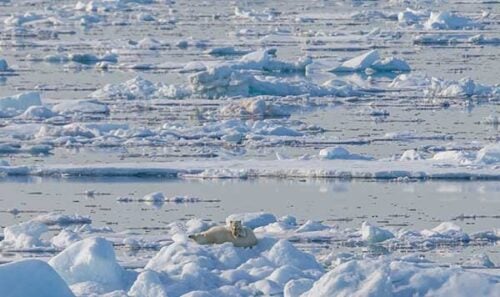
For those who might not be PFAS researchers or chemistry enthusiasts, PFAS are hydrophilic: they love the water, dissolve into water, and remain there.
The opposite of this is hydrophobic, meaning fear of water, or, more scientifically, a low ability to remain dissolved in water. Think of oil in salad dressing– a layer that sits on top and doesn’t mix with the water below. It’s hydrophobicity in action. Many contaminants of concern predating PFAS, like DDT or PCBs, were hydrophobic. When they were released to water, like the ocean, they were quick to either volatilize into the air or bind down into sediments. Many PFAS, including those well-researched and regulated, are more likely to stay in the water compared to these legacy contaminants of concern.
While STEEP is an interdisciplinary NIEHS Superfund Center, a subset of the scientists researching PFAS are oceanographers by trade. STEEP Director Rainer Lohmann, PhD and his lab are based on the University of Rhode Island’s Bay campus, at the Graduate School of Oceanography. And in the ocean state, it’s important to remember that the human-ocean link is incredibly important, even when it comes to PFAS.
As such, STEEP has a vibrant oceanic PFAS research portfolio from which to draw. Most recently, STEEP researchers, including the author of this article, observed equal amounts of PFAS traveling into and out of the Fram Strait, the “gateway to the Arctic.” Point sources in the polar region do contribute to this import/export balance, but it’s also important to note that the water-loving chemical composition and inherent persistence of PFAS matters, too. This means some of the PFAS that reach the ocean, travel all the way north away from us here in Rhode Island, are capable of returning back down to us via these currents. More specifically, the PFAS were transported back south into the Atlantic Ocean from the Arctic region in re-circulating Atlantic and Arctic waters. There’s very little loss to sediment, as the PFAS stay dissolved in the water, and their persistence means no breakdown for long periods of time. I like to call this the “fluorinated feedback loop.”
Recently, a study created quite a stir after The Guardian released a story documenting these findings. Turns of phrase within the article were impressive, but a bit misleading, if you ask me:
“Ocean waves crashing on the world’s shores emit more PFAS into the air than the world’s industrial polluters, new research has found, raising concerns about environmental contamination and human exposure along coastlines.”
Yes, the research study did suggest that ocean waves were emitting a very large (and startling) quantity of PFAS into the air. However, to imply it is emitting more PFAS than industrial polluters is oxymoronic.
PFAS are not a naturally occurring contaminant, so the ocean isn’t emitting PFAS of its own creation. It’s emitting PFAS from industrial polluters, after traveling long distance sequestered in ocean water. In fact, the ocean is considered the final “sink” for most man-made contaminants, especially PFAS, because of hydrophilic chemistry. A sink is the sort of final reservoir for all contaminants. Once they travel down your river, or down your drain, they ultimately end up somewhere: that somewhere is the ocean.
But the results of this study underscore the existence of the fluorinated feedback loop. PFAS that reach the environment, some by atmospheric transport, collect in the ocean, may become concentrated at the surface layer, and re-emitted into the atmosphere once again. When you consider the observations of our recent STEEP research, which found nearly equal amounts of PFAS moving into and out of the Fram Strait, it appears that the ocean may not be the ultimate sink for PFAS after all. To be more specific, what has flushed out of our rivers, from our coastlines, literally, out of our homes, may be able, once again, to recirculate and return to us again, be it on a nice breeze or in ocean spray.
The continued persistence of PFAS in the oceans only emphasizes the need for research into long term PFAS storage and transport. While the sea spray article from The Guardian is sure to garner many clicks, hopefully the interest in the cited research will also lead to follow up studies, evaluating this new pathway and the fluorinated feedback loop.
Within STEEP, ongoing research is focused on the fate of PFAS in the ocean, especially within Project 4 under the leadership of Lohmann. A bevy of graduate students sample on the frontlines: PhD candidates Jarod Snook and Asta Habtemichael joined fellow STEEP scientists on a cruise in October 2022 to sample water and phytoplankton from the Gulf of Maine. Other doctoral students including the recently featured Izak Hill, and onboarded Rachel Nelson, Taylor Elpers, and Justin Sankey continue STEEP’s work to evaluate PFAS uptake by coastal and ocean life, including fish, birds, zooplankton, and kelp.
PFAS created by industrial production are here to stay, even in our ever-changing ocean. Exposure was once thought to be washed out to sea, but we know the need for strong ocean science has never been more critical. Be it from sea surface aerosol spray, recirculating ocean currents, or seafood, we have a lot more to unwind in the story of the fluorinated feedback loop.
Written by Matt Dunn, PhD, former STEEP trainee. Dunn now works for RPS ASA as a Contaminant Modeler, but moonlights as a freelance writer and editor. We have been grateful to passively sample some of his time (that’s a PFAS joke).

